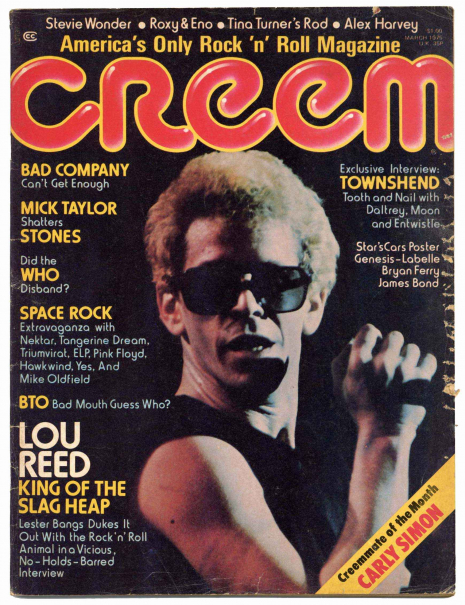
If you are a big “rock” fan of a certain age—and American—you almost certainly grew up reading CREEM magazine. I sure did. I loved CREEM. The magazine was one of the first indications to my young mind that there was a much bigger, much badder and much cooler world outside of my dingy hometown. I read every issue until I memorized the articles. It informed my foundational musical tastes more than any other influence, and by some margin. Even the way I write.
The very first time I bought CREEM was the March 1975 Lou Reed cover. I spotted it in a downmarket hillbilly grocery store in Wheeling, WV. It looked weird and interesting. Certainly it stood out on the newstand of the era. I was a nine-year-old kid who’d only recently moved on from Planet of the Apes and James Bond movies after hearing “Space Oddity” on AM radio late one night and having my mind completely blown. I knew there was some connection between David Bowie and Lou Reed, but that was about it. What made me decide to spend my weekly $1 allowance on the magazine was the title the author, Lester Bangs, had given that cover story: “Let Us Now Praise Famous Death Dwarves (or how I slugged it out with Lou Reed and stayed awake).” I found this very intriguing and mysterious. I wanted to get to the bottom of it. What’s a death dwarf? And why was Lou Reed a famous one?
That legendary encounter between Reed and Bangs is today something studied at universities, an iconic bit of rock lore and a classic piece of gonzo journalism. It had a tremendous hold on my not-so-innocent young imagination. It might have been the first thing I’d ever read that made drugs seem really cool. It also made me want to talk—and write—just like Lester Bangs. As a literary stylist I put him on the same level as Kurt Vonnegut, that’s how much I liked what he did. Plus Bangs had tremendous taste in music. If he championed a group or performer, I had to hear it, even if that meant—in the case of the Velvet Underground or the Stooges—doing yard work for my parents and neighbors until I could save up enough money to buy German imports via Moby Disc, an LA-based record store that advertised their mail-order business in CREEM. (My mother had to get money orders from the post office for me to do this. It would take four to six weeks to get the album, but if you were in a rural area, this was your only option back then. If anything it goes to show the lengths someone would go to purchase as-yet-unheard music that Bangs had rhapsodized about. His prose was so good and evocative that I just knew—I was sure of it—that if he was enthusiastic about something, I was no doubt going to love it, too. Lester never let me down, not ever, not once.)
I discovered so many things via CREEM: Obviously Lou Reed and the Velvet Underground, the Stooges, Hawkwind, Kraftwerk, Patti Smith, MC5, the New York Dolls, Ramones, Sex Pistols, the Clash. Yeah, CREEM really warped me, but in a good way. Had I not found it when I did, who knows, I might have gone on to become a respectable adult.
It should come as no surprise then, reader, that I heartily enjoyed the new documentary, CREEM: America’s Only Rock ‘n’ Roll Magazine. The briskly-paced, well art-directed film was produced by JJ Kramer—son of CREEM publisher Barry Kramer—and directed by Scott Crawford, who made 2014’s Salad Days: A Decade of Punk in Washington DC, 1980-90. It’s a real family affair—they had access to everything—but not in a way that pulls any punches about some of the complex personalities involved. You get the viewpoint of many of the insiders who were actually there (including Dave Marsh, Greil Marcus and co-producer Jaan Uhelszki) and several notables who weren’t, but who were greatly influenced by the gang of misfits who produced the magazine (Chad Smith of the Red Hot Chili Peppers tells the charming tale of realizing that CREEM had moved their offices to his Michigan hometown and riding his bike over there only to see Alice-fucking-Cooper on his way out the front door!)
This is a really great time capsule pop culture piece and a film that needed to be made just for history’s sake, but it’s not merely a nostalgia stroll for old men. A young person watching this doc, especially in the context of what’s happening globally, sees the birth of a scene and how it was the sheer force of Barry Kramer’s personality that initially birthed it, but also how CREEM became this strange attractor of such bright-burning talent. If you read between lines (of speed, coke or “green”—some of you will hear that dog whistle) the takeaway, dear young people of 2020 is that if you want your own scene, you gotta start it yourself.
Recommended.
CREEM: America’s Only Rock ‘n’ Roll Magazine is released Friday, August 7, on digital and in theaters.